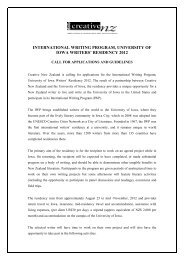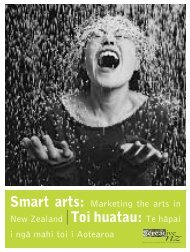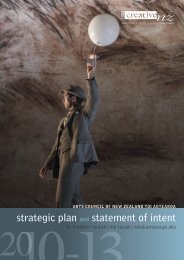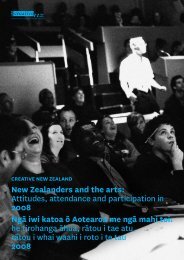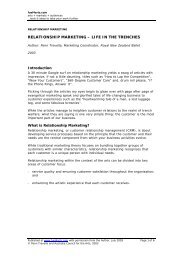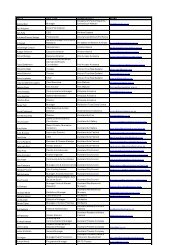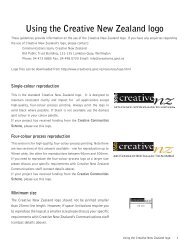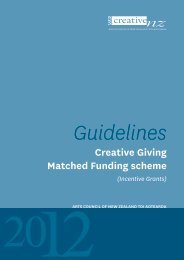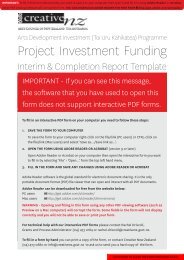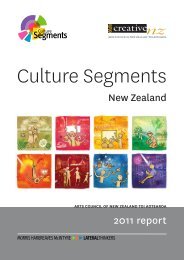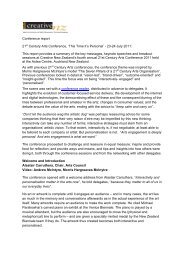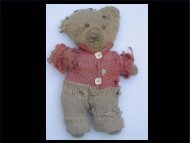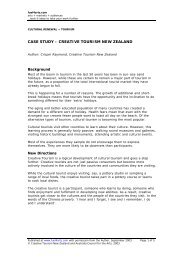FULL HOUSE Turning Data into Audiences - Creative New Zealand
FULL HOUSE Turning Data into Audiences - Creative New Zealand
FULL HOUSE Turning Data into Audiences - Creative New Zealand
You also want an ePaper? Increase the reach of your titles
YUMPU automatically turns print PDFs into web optimized ePapers that Google loves.
INTRODUCTION<br />
This new Manual is fundamentally about what arts<br />
and entertainment organisations can do to better<br />
utilise the data they have regarding customers and<br />
their transactions and build ongoing relationships.<br />
The original Manual published in the UK in 1993 was<br />
intended to help all those who wanted to get more<br />
out of the box office, usually the main point of contact<br />
with customers. More was wanted from the staff who<br />
worked there, and more from the data on customers<br />
and their transactions which should be available from a<br />
computerised system. This needed a fundamental change<br />
in attitude both to customers at every contact point<br />
and the customer-facing functions. Most importantly,<br />
it required recognition that arts and entertainment<br />
organisations needed to build relationships with their<br />
attenders. They needed to use the knowledge they<br />
had about them to create more effective relationships,<br />
to the benefit of the attender and the organisation.<br />
Some might argue that this has been achieved. Yet the<br />
evidence is that in 2006, many arts and entertainment<br />
organisations are still not recognising the value of data on<br />
their customers’ behaviours, and are as likely to be ‘productfocussed’<br />
and not necessarily ‘customer-focussed’. In the<br />
21st century, many are still only slowly realising the value<br />
of building close and valuable relationships with attenders.<br />
Many still sell tickets through agents and only have an<br />
‘arm’s length’ relationship with their customers; and as a<br />
result lack full information on them and their transactions.<br />
Change is slow. It was the early 1980s when the first<br />
computerised ticket selling systems arrived in larger venues<br />
elsewhere in the world. These were soon followed by<br />
systems designed to combine marketing and fund-raising<br />
facilities with ticketing functions, offering fully developed<br />
integral customer databases, list management facilities, and<br />
the capability to record more information about customers<br />
and their purchasing habits. This transformed both the<br />
function of the box office and the marketing capabilities, as<br />
well as the relationship between customer and box office.<br />
In the 1990s, systems set out to create a single database<br />
to support customer-facing functions, encompassing<br />
not just ticketing and marketing, but also memberships,<br />
subscriptions, season tickets, donations, corporate<br />
giving and fund-raising, to be served up to the staff at<br />
every customer ‘touch-point’. The challenge has been to<br />
integrate these different marketing activities and coordinate<br />
the various ‘silos’ of customer information often<br />
collected by different departments with different tools.<br />
In 2006 this is evolving to yet a new level. The Internet<br />
has transformed how customers can find out about arts<br />
and entertainment organisations. It has also changed how<br />
we communicate directly with them, in a tailored and<br />
personalised way, using the data from their relationship<br />
in all transactions. From website to ticket sale and at<br />
every contact point, it is possible to know who the<br />
customer is and deal with them according to their<br />
specific needs and interests. We have to put an end to<br />
“faux” relationship marketing, as Don Pepper refers to<br />
it (explained more in Chapter 2). The customers know<br />
what we know about them, and expect us to use it in<br />
relating to them. This needs a fundamental change in<br />
approach to using and managing that knowledge.<br />
This Manual is about managing that change<br />
and getting the best out of it.<br />
. Don Pepper and Martha Rogers, The One to One Future<br />
published 1993, then 1996, and as Fieldbook in 1999. The concept<br />
of “faux” relationship marketing is described as not using what is<br />
known about the customer when communicating with them.<br />
viii<br />
<strong>FULL</strong> <strong>HOUSE</strong>: <strong>Turning</strong> <strong>Data</strong> <strong>into</strong> <strong>Audiences</strong> © Roger Tomlinson & Tim Roberts



